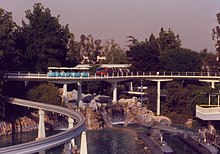
A people mover or automated people mover (APM) is a type of small scale automated guideway transit system. The term is generally used only to describe systems serving relatively small areas such as airports, downtown districts or theme parks.
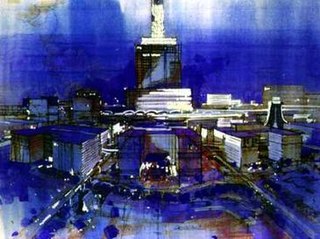
The Experimental Prototype Community of Tomorrow, shortened to EPCOT or E.P.C.O.T., is an unfinished concept for a planned community, intended to sit on a massive swath of undeveloped land near Orlando, Florida, that was developed by Walt Disney in collaboration with the designers at Walt Disney Imagineering in the 1960s. Based on ideas stemming from modernism and futurism, and inspired by architectural literature about city planning, Disney intended EPCOT to be a utopian autocratic company town. One of the primary stated aims of EPCOT was to replace urban sprawl as the organizing force of community planning in the United States in the 1960s. Disney intended EPCOT to be a real city, and it was planned to feature commercial, residential, industrial and recreational centers, connected by a mass multimodal transportation system, that would, he said, "Never cease to be a living blueprint of the future."
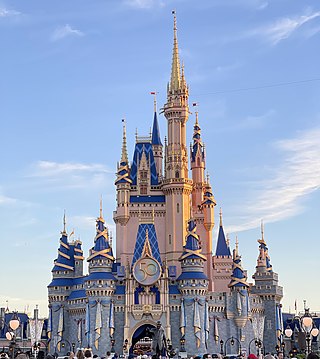
Magic Kingdom Park, previously known as Walt Disney World Magic Kingdom (1971–1994) and The Magic Kingdom (1994–2017), is a theme park at the Walt Disney World Resort in Bay Lake, Florida, near Orlando, Florida. Owned and operated by The Walt Disney Company through its Parks, Experiences and Products division, the park opened on October 1, 1971, as "Walt Disney World Magic Kingdom", the first of four theme parks at the resort. The park was initialized by Walt Disney and designed by WED Enterprises. Its layout and attractions are based on Disneyland Park in Anaheim, California, and are dedicated to fairy tales and Disney characters.

Matterhorn Bobsleds are a pair of intertwined steel roller coasters at Disneyland in Anaheim, California. It is modeled after the Matterhorn, a mountain in the Alps on the border between Switzerland and Italy. It is the first known tubular steel track roller coaster. Located on the border between Tomorrowland and Fantasyland, it employs forced perspective to seem larger.

The PeopleMover is an urban mass transit PeopleMover system attraction in Tomorrowland in the Magic Kingdom at the Walt Disney World Resort in Bay Lake, Florida just outside of Orlando, Florida. Designed as an urban mass-transit system of the future, vehicles take passengers on a grand circle tour of the realm of Tomorrowland that provides elevated views of several other attractions.
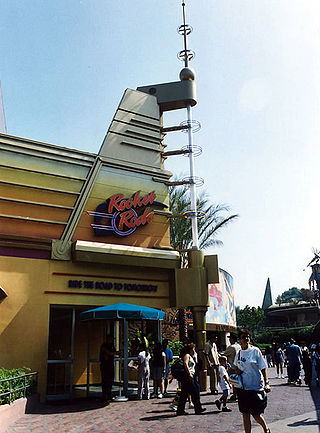
Rocket Rods was a high-speed thrill attraction in Tomorrowland at Disneyland in Anaheim, California. The ride, meant to evoke a futuristic rapid transit system, opened in 1998 on the existing PeopleMover infrastructure as part of the New Tomorrowland project. Plagued with technical problems, Rocket Rods was shut down for renovations in September 2000, but was confirmed to be closed permanently via an official press release in April 2001 after a little over two years of intermittent operation. While Rocket Rods' queue was replaced with Buzz Lightyear Astro Blasters in 2005, the majority of the track infrastructure utilized by both the attraction and its predecessor sit visibly derelict throughout Tomorrowland as of 2022.

Tomorrowland is one of the many themed lands featured at all of the Magic Kingdom styled Disney theme parks around the world owned or licensed by The Walt Disney Company. Each version of the land is different and features numerous attractions that depict views of the future. Disneyland Park in Paris includes a similar area called Discoveryland, which shares some elements with other Tomorrowlands but emphasizes visions of the future inspired by Jules Verne.

The Disneyland Monorail is an attraction and transportation line at the Disneyland Resort in Anaheim, California, United States. It was the first daily operating monorail in the Western Hemisphere.

Autopia is a race car track Disneyland attraction, in which patrons steer specially designed cars through an enclosed track. Versions of Autopia exist at Anaheim, California and Disneyland Paris in Marne-la-Vallée, France. There was also an Autopia at Hong Kong Disneyland on Lantau Island, Hong Kong before it closed on June 11, 2016. Other versions of the attraction can be found at the Magic Kingdom as the Tomorrowland Speedway and formerly at Tokyo Disneyland as the Grand Circuit Raceway. A previous generation of Disneyland's Autopia operated for over a decade at the Walt Disney Hometown Museum in Marceline, Missouri; one of the retired cars is now on display.
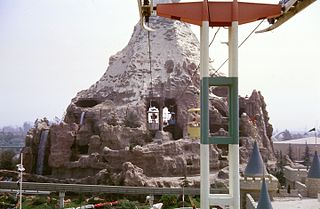
The Skyway was a gondola lift attraction at Disneyland, at the Magic Kingdom, and at Tokyo Disneyland. Since all versions of this attraction took riders back and forth between Fantasyland and Tomorrowland, the route from Tomorrowland was called Skyway to Fantasyland, and the route from Fantasyland was called Skyway to Tomorrowland.

The Astro Orbiter is a "rocket-spinner", aerial carousel-type attraction featured at five Disneyland-style parks and Walt Disney Resorts around the world, except for Tokyo Disneyland. Although each ride may have a slightly different name, all share the same experience of vehicles traveling through space, spinning around a central monument. In most forms of the ride, the use of a joystick enables guests to adjust the height of their individual cars at will, usually within a range of no more than 10-15 feet. When the ride cycle comes to its completion, any ascended vehicles are automatically lowered for passenger exit and re-boarding. Over the years, with each new iteration of the ride debuting, new designs, thematic schemes, and locations have been implemented to fit with the changing themes of several Tomorrowlands.
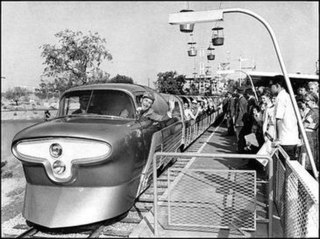
The Viewliner Train of Tomorrow was a 2 ft 6 in narrow-gauge, miniature train that once operated alongside portions of the Disneyland Railroad main line.
Motor Boat Cruise was an attraction at Disneyland in Anaheim, California, in which patrons steer motor boats, which were guided through a hidden track similar to the Autopia ride. It operated from June 1957 until January 11, 1993.

Space Mountain is an outer space-themed, indoor roller coaster in Tomorrowland located at Walt Disney World's Magic Kingdom theme park in Bay Lake, Florida, near Orlando. The dark ride, which opened on January 15, 1975, is the original version of the iconic attraction that has since been replicated at other Disney theme park locations worldwide, with the exception of Shanghai Disneyland Resort. Space Mountain is also the oldest operating roller coaster in the state of Florida. RCA helped fund construction and sponsored the ride from 1975 to 1993. FedEx assumed sponsorship from 1994 to 2004.

Space Mountain is an indoor, space-themed roller coaster in Tomorrowland at Disneyland in Anaheim, California. Opened on May 27, 1977, it was the second roller coaster built at Disneyland, and was the second of the five versions of Space Mountain built by The Walt Disney Company. Its exterior façade is one of Disneyland's four "mountain" structures that serve as park landmarks.

Space Mountain at Tokyo Disneyland opened with the park on April 15, 1983. It was the first version of Space Mountain to open concurrently with the park. As with the other Space Mountains, this version is also popular with young adults and roller coaster fans. Along with its Walt Disney World counterpart prior to 2010, it is currently one of the only Space Mountains without an on-board soundtrack.

Rail transport can be found in every theme park resort property owned or licensed by Disney Parks, Experiences and Products, one of the four business segments of the Walt Disney Company. The origins of Disney theme park rail transport can be traced back to Walt Disney himself and his personal fondness for railroads, who insisted that they be included in the first Disney park, the original Disneyland in California in the United States, which opened on July 17, 1955. The Disney tradition of including transport by rail in, and adjacent to, its parks has since been extended to other Disney properties with the opening of Walt Disney World in Florida in the United States, Tokyo Disney Resort in Japan, Disneyland Paris in France, Hong Kong Disneyland Resort in China, and Shanghai Disney Resort in China. The Disney theme park chain is the largest on the planet by annual attendance with over 155 million visitors in 2019, and the rail systems located inside its properties play key roles as modes of transportation and as attractions for its visitors.

The Walt Disney Hometown Museum is located in the restored Santa Fe Railway Depot in Marceline, Missouri. Opened in 2001, the museum houses a collection of memorabilia from the Disney family's farm where they lived from 1905 to 1909 along with Walt Disney's return to the town in 1946.

TRON Lightcycle Power Run and TRON Lightcycle / Run are semi-enclosed, launched roller coasters located at Shanghai Disneyland and Magic Kingdom in Walt Disney World. The first incarnation, Tron Lightcycle Power Run, opened at Shanghai Disneyland on June 16, 2016. A nearly-identical installation, Tron Lightcycle / Run, opened at Magic Kingdom in Walt Disney World on April 4, 2023. Both are situated within the Tomorrowland themed areas at each park.

